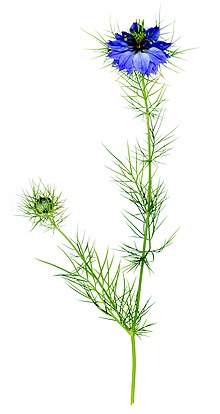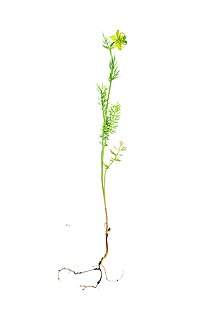Nigella is a genus of 18 species[1] of annual plants in the family Ranunculaceae, native to Southern Europe, North Africa, South Asia, Southwest Asia and Middle East. Common names applied to members of this genus are nigella, devil-in-a-bush or love-in-a-mist.
| Nigella | |
|---|---|

| |
| Nigella damascena | |
| Scientific classification | |
| Kingdom: | Plantae |
| Clade: | Tracheophytes |
| Clade: | Angiosperms |
| Clade: | Eudicots |
| Order: | Ranunculales |
| Family: | Ranunculaceae |
| Subfamily: | Ranunculoideae |
| Tribe: | Nigelleae |
| Genus: | Nigella L. |
| Species | |
| |



The species grow to 20–90 cm (8–35 in) tall, with finely divided leaves; the leaf segments are narrowly linear to threadlike. The flowers are white, yellow, pink, pale blue or pale purple, with five to ten petals. The fruit is a capsule composed of several united follicles, each containing numerous seeds; in some species (e.g. Nigella damascena), the capsule is large and inflated.
Uses edit
Culinary edit
The seeds of Nigella sativa, known as kalonji, black cumin, black caraway, black coriander, roman coriander, black onion seed, onion seed, charnushka, git (in historical Roman cuisine),[2] or just nigella, are used as a spice and a condiment in South Asian, Ethiopian, Middle Eastern and Polish cuisines.[3]
Garden flowers edit
Several species are grown as ornamental plants in gardens. Nigella damascena has been grown in English cottage gardens since the Elizabethan era, commonly called love-in-a-mist. Nigella hispanica is a taller species with larger blue flowers, red stamens, and grey leaves. Nigella seeds are self-sowing if the seed pods are left to mature.
The dried seed capsules can also be used in flower arrangements.
Use in healthcare edit
In traditional medicine, the seeds are used as a carminative and stimulant to ease bowel and indigestion problems, and are given to treat intestinal worms, nerve defects, to reduce flatulence, and induce sweating. Dried pods are sniffed to restore a lost sense of smell. It is also used to repel some insects, much like mothballs.
Numerous studies have shown that it has anti-inflammatory,[4] anti-oxidative,[5] anti-mycotic, antibacterial,[6][7][8] anti-fungal, anti-cancer,[9][10][11][12][13] anti-viral, antihistamine properties, possessing many properties that make it a potential remedy against certain diseases.[14]
Black cumin is used in naturopathy. Black cumin oil or powder are used in the treatment of pathologies such as skin diseases, muscle pain, eczema or psoriasis,[15] but also acne,[16] diabetes, asthma,[17] A 2014 study showed its positive effects on the harmful effects of radiotherapy treatments.[18]
Nigella oil contains almost 60% linoleic acid (omega 6).
It is available in capsule, oil or powder form, with both internal and external uses (in massages).
In Silico study of 96 phytochemical compounds of Nigella sativa, identifying Nigelladine A as the most promising compound for SARS-CoV-2 inhibition with the highest docking scores for the spike protein and Mpro. Thymoquinone is a phytochemical compound found in the plant Nigella sativa. Dithymoquinone, kaempferol, Nigelladine B, Nigelladine, and Nigelladine sulphate also showed high docking scores.[19]
References edit
- ^ "Nigella". The Plant List. Retrieved 2020-04-27.
- ^ Monaco, Farrel (17 August 2019). "Baking with the Romans--The Key Ingredient: Git".[self-published source?]
- ^ Malhotra, S.K. (2004). "Nigella". In Peter, K. V. (ed.). Handbook of Herbs and Spices. pp. 206–214. doi:10.1533/9781855738355.2.206. ISBN 978-1-85573-721-1.
- ^ Khader, Mohannad; Eckl, Peter M. (December 2014). "Thymoquinone: an emerging natural drug with a wide range of medical applications". Iranian Journal of Basic Medical Sciences. 17 (12): 950–957. PMC 4387230. PMID 25859298.
- ^ Entok, Emre; Ustuner, Mehmet Cengiz; Ozbayer, Cansu; Tekin, Neslihan; Akyuz, Fahrettin; Yangi, Berat; Kurt, Hulyam; Degirmenci, Irfan; Gunes, Hasan Veysi (May 2014). "Anti-inflammatuar and anti-oxidative effects of Nigella sativa L.: 18FDG-PET imaging of inflammation". Molecular Biology Reports. 41 (5): 2827–2834. doi:10.1007/s11033-014-3137-2. PMID 24474661. S2CID 254840880.
- ^ Bakathir, Hussein Ahmed; Abbas, Nageeb Ahmed (2011). "Detection of the antibacterial effect of Nigella sativa ground seeds with water". African Journal of Traditional, Complementary and Alternative Medicines. 8 (2): 159–164. doi:10.4314/ajtcam.v8i2.63203. PMC 3252685. PMID 22238497.
- ^ Chaieb, Kamel; Kouidhi, Bochra; Jrah, Hanene; Mahdouani, Kacem; Bakhrouf, Amina (13 April 2011). "Antibacterial activity of Thymoquinone, an active principle of Nigella sativa and its potency to prevent bacterial biofilm formation". BMC Complementary and Alternative Medicine. 11: 29. doi:10.1186/1472-6882-11-29. PMC 3095572. PMID 21489272.
- ^ Kokoska, L.; Havlik, J.; Valterova, I.; Sovova, H.; Sajfrtova, M.; Jankovska, I. (December 2008). "Comparison of Chemical Composition and Antibacterial Activity of Nigella sativa Seed Essential Oils Obtained by Different Extraction Methods". Journal of Food Protection. 71 (12): 2475–2480. doi:10.4315/0362-028x-71.12.2475. PMID 19244901.
- ^ Majdalawieh, Amin F.; Hmaidan, Reem; Carr, Ronald I. (15 September 2010). "Nigella sativa modulates splenocyte proliferation, Th1/Th2 cytokine profile, macrophage function and NK anti-tumor activity". Journal of Ethnopharmacology. 131 (2): 268–275. doi:10.1016/j.jep.2010.06.030. PMID 20600757.
- ^ Cikman, Oztekin; Ozkan, Adile; Aras, Adem Bozkurt; Soylemez, Omer; Alkis, Hilal; Taysi, Seyithan; Karaayvaz, Muammer (October 2014). "Radioprotective effects of Nigella sativa oil against oxidative stress in liver tissue of rats exposed to total head irradiation". Journal of Investigative Surgery. 27 (5): 262–266. doi:10.3109/08941939.2014.898811. PMID 24679182. S2CID 23302168.
- ^ Aikemu, Ainiwaer; Xiaerfuding, Xiadiya; Shiwenhui, Chengyufeng; Abudureyimu, Meiliwan; Maimaitiyiming, Dilinuer (July 2013). "Immunomodulatory and anti-tumor effects of Nigella glandulifera freyn and sint seeds on ehrlich ascites carcinoma in mouse model". Pharmacognosy Magazine. 9 (35): 187–191. doi:10.4103/0973-1296.113258. PMC 3732418. PMID 23929999.
- ^ Arafa, El-Shaimaa A.; Zhu, Qianzheng; Shah, Zubair I.; Wani, Gulzar; Barakat, Bassant M.; Racoma, Ira; El-Mahdy, Mohamed A.; Wani, Altaf A. (10 January 2011). "Thymoquinone up-regulates PTEN expression and induces apoptosis in doxorubicin-resistant human breast cancer cells". Mutation Research. 706 (1–2): 28–35. doi:10.1016/j.mrfmmm.2010.10.007. PMC 3037029. PMID 21040738.
- ^ El-Mahdy, Mohamed A.; Zhu, Qianzheng; Wang, Qi-En; Wani, Gulzar; Wani, Altaf A. (10 November 2005). "Thymoquinone induces apoptosis through activation of caspase-8 and mitochondrial events in p53-null myeloblastic leukemia HL-60 cells". International Journal of Cancer. 117 (3): 409–417. doi:10.1002/ijc.21205. PMID 15906362. S2CID 35725411.
- ^ Yimer, Ebrahim M.; Tuem, Kald Beshir; Karim, Aman; Ur-Rehman, Najeeb; Anwar, Farooq (12 May 2019). "Nigella sativa L. (Black Cumin): A Promising Natural Remedy for Wide Range of Illnesses". Evidence-Based Complementary and Alternative Medicine. 2019: 1528635. doi:10.1155/2019/1528635. PMC 6535880. PMID 31214267.
- ^ Eid, Ahmad M.; Elmarzugi, Nagib A.; Abu Ayyash, Laila M.; Sawafta, Maher N.; Daana, Hadeel I. (2017). "A Review on the Cosmeceutical and External Applications of Nigella sativa". Journal of Tropical Medicine. 2017: 7092514. doi:10.1155/2017/7092514. PMC 5735686. PMID 29358959.
- ^ Naseer A., Hadi; Ammar Waham, Ashor (2010). "Nigella sativa oil lotion 20% vs. benzoyl peroxide lotion 5% in the treatment of mild to moderate acne vulgaris". Iraqi Postgraduate Medical Journal. 9 (4): 371–376.
- ^ Koshak, Abdulrahman; Wei, Li; Koshak, Emad; Wali, Siraj; Alamoudi, Omer; Demerdash, Abdulrahman; Qutub, Majdy; Pushparaj, Peter Natesan; Heinrich, Michael (March 2017). "Nigella sativa Supplementation Improves Asthma Control and Biomarkers: A Randomized, Double-Blind, Placebo-Controlled Trial". Phytotherapy Research. 31 (3): 403–409. doi:10.1002/ptr.5761. PMID 28093815. S2CID 25341730.
- ^ Cikman, Oztekin; Ozkan, Adile; Aras, Adem Bozkurt; Soylemez, Omer; Alkis, Hilal; Taysi, Seyithan; Karaayvaz, Muammer (October 2014). "Radioprotective Effects of Nigella Sativa Oil Against Oxidative Stress in Liver Tissue of Rats Exposed to Total Head Irradiation". Journal of Investigative Surgery. 27 (5): 262–266. doi:10.3109/08941939.2014.898811. PMID 24679182. S2CID 23302168.
- ^ Miraz, Md Mehedy Hasan; Ullah, Md Afif; Nayem, Abdullah Al; Chakrobortty, Brototi; Deb, Sanjoy; Laskar, Anee; Tithi, Nishita Umaya; Saha, Nilay; Chowdhury, Anita Rani; Alam, K. M. Khairul; Wahed, Tania Binte; Khursheed Alam, Mohammad; Kundu, Sukalyan Kumar (20 February 2023). "Nigelladine A among Selected Compounds from Nigella sativa Exhibits Propitious Interaction with Omicron Variant of SARS-CoV-2: An In Silico Study". International Journal of Clinical Practice. 2023: e9917306. doi:10.1155/2023/9917306. PMC 9970708. PMID 36861057.
External links edit
Media related to Nigella at Wikimedia Commons